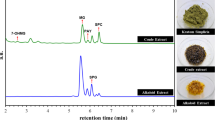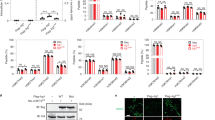Abstract
NF-κB is a critical activator of genes involved in inflammation and immunity1,2. Pro-inflammatory cytokines activate the IκB kinase (IKK) complex that phosphorylates the NF-κB inhibitors, triggering their conjugation with ubiquitin and subsequent degradation3,4. Freed NF-κB dimers translocate to the nucleus and induce target genes, including the one for cyclo-oxygenase 2 (COX2), which catalyses the synthesis of pro-inflammatory prostaglandins, in particular PGE5,6. At late stages of inflammatory episodes, however, COX2 directs the synthesis of anti-inflammatory cyclopentenone prostaglandins, suggesting a role for these molecules in the resolution of inflammation7. Cyclopentenone prostaglandins have been suggested to exert anti-inflammatory activity through the activation of peroxisome proliferator-activated receptor-γ (refs 8, 9). Here we demonstrate a novel mechanism of anti-inflammatory activity which is based on the direct inhibition and modification of the IKKβ subunit of IKK. As IKKβ is responsible for the activation of NF-κB by pro-inflammatory stimuli10,11, our findings explain how cyclopentenone prostaglandins function and can be used to improve the utility of COX2 inhibitors.
This is a preview of subscription content, access via your institution
Access options
Subscribe to this journal
Receive 51 print issues and online access
$199.00 per year
only $3.90 per issue
Buy this article
- Purchase on SpringerLink
- Instant access to full article PDF
Prices may be subject to local taxes which are calculated during checkout






Similar content being viewed by others
References
Baldwin,A. S. The NF-κB and IκB proteins: new discoveries and insights. Annu. Rev. Immunol. 14, 649–683 (1996).
Barnes,P. J. & Karin,M. Nuclear factor-κB—a pivotal transcription factor in chronic inflammatory diseases. New Engl. J. Med. 336, 1066–1071 (1997).
DiDonato,J. A., Hayakawa,M., Rothwarf,D. M., Zandi,E. & Karin,M. A cytokine-responsive IκB kinase that activates the transcription factor NF-κB. Nature 388, 548–554 (1997).
Zandi,E., Chen,Y. & Karin,M. Direct phosphorylation of IκB by IKKα and IKKβ: discrimination between free and NF-κB-bound substrate. Science 281, 1360–1363 (1998).
Herschman,H. R. et al. Function and regulation of prostaglandin synthase-2. Adv. Exp. Med. Biol. 407, 61–66 (1997).
Newton,R., Kintert,L. M. E., Bergmann,M., Adcock,I. M. & Barnes,P. I. Evidence for involvement of NF-κB in the transcriptional control of COX-2 gene expression by IL-1β. Biochem. Biophys. Res. Comm. 237, 28–32 (1997).
Gilroy,D. W. et al. Inducible cyclooxygenase may have anti-inflammatory properties. Nature Med. 5, 698–701 (1999).
Ricote,M., Li,A. C., Willson,T. M., Kelly,C. J. & Glass,C. K. The peroxisome proliferator-activated receptor-γ is a negative regulator of macrophage activation. Nature 391, 79–82 (1998).
Jiang,C., Ting,A. T. & Seed,B. PPAR-γ agonists inhibit production of monocyte inflammatory cytokines. Nature 391, 82–86 (1998).
Delhase,M., Hayakawa,M., Chen,Y. & Karin,M. Positive and negative regulation of IκB kinase activity through IKKβ subunit phosphorylation. Science 284, 309–313 (1999).
Tanaka,M. et al. Embryonic lethality, liver degeneration and impaired NF-κB activation in IKK-β-deficient mice. Immunity 10, 421–429 (1999).
Santoro,M. G. Antiviral activity of cyclopentenone prostanoids. Trends Microbiol. 5, 276–281 (1997).
Rozera,C. et al. Inhibition of HIV-1 replication by cyclopentenone prostaglandins in acutely infected human cells. J. Clin. Invest. 97, 1795–1803 (1996).
Rossi,A., Elia,G. & Santoro,M. G. Inhibition of nuclear factor κB by prostaglandin A1: an effect associated with heat shock transcription factor activation. Proc. Natl Acad. Sci. USA 94, 746–750 (1997).
Rothwarf,D. M., Zandi,E., Natoli,G. & Karin,M. IKK-γ is an essential regulatory subunit of the IκB kinase complex. Nature 395, 297–300 (1998).
Yamaoka,S. et al. Complementation cloning of NEMO, a component of the IκB kinase complex essential for NF-κB activation. Cell 93, 1231–1240 (1998).
Karin,M. & Delhase,M. JNK or IKK, AP-1 or NF-κB, which are the targets for MEK kinase 1 action? Proc. Natl Acad. Sci. USA 95, 9067–9069 (1998).
Yin,M., Yamamoto,Y. & Gaynor,R. B. The anti-inflammatory agents aspirin and salicylate inhibit the activity of IκB kinase-β. Nature 398, 77–80 (1998).
Fukushima,M. Prostaglandin J2-anti-tumor and anti-viral activities and the mechanisms involved. Eicosanoids 3, 189–199 (1990).
Rossi,A., Elia,G. & Santoro,M. G. 2-Cyclopenten-1-one, a new inducer of heat shock protein 70 with antiviral activity. J. Biol. Chem. 271, 32192–32196 (1996).
Gray,N. S. et al. Exploiting chemical libraries, structure and genomics in the search for kinase inhibitors. Science 281, 533–537 (1998).
Santoro,M. G., Garaci,E. & Amici,C. Prostaglandins with antiproliferative activity induce the synthesis of a heat shock protein in human cells. Proc. Natl Acad. Sci. USA 86, 8407–8411 (1989).
Santoro,M. G., Benedetto,A., Carruba,G., Garaci,E. & Jaffe,B. M. Prostaglandin A compounds as antiviral agents. Science 209, 1032–1034 (1980).
Staels,B. et al. Activation of human aorta smooth-muscle cells is inhibited by PPARα but not by PPARγ activators. Nature 393, 790–793 (1998).
Serhan,C. N., Haeggström,J. Z. & Leslie,C. C. Lipid mediator networks in cell signaling: update and impact of cytokines. FASEB J. 10, 1147–1158 (1996).
Calderwood,S. K., Bornstein,B., Farnum,E. K. & Stevenson,M. A. Heat shock stimulates the release of arachidonic acid and the synthesis of prostaglandins and leukotriene B4 in mammalian cells. J. Cell Physiol. 141, 325–333 (1989).
Leung,D. Y. et al. Increased in vitro bone resorption by monocytes in the hyper-immunoglobulin E syndrome. J. Immunol. 140, 84–88 (1988).
Offenbacher,S., Odle,B. M. & Van Dyke,T. E. The use of crevicular fluid prostaglandin E2 levels as a predictor of periodontal attachment loss. J. Periodontal Res. 21, 101–112 (1986).
Wang,C. Y., Mayo,M. W. & Baldwin,A. S. TNF and cancer therapy-induced apoptosis: potentiation by inhibition of NF-κB. Science 274, 786–787 (1998).
Hirose,S. et al. Expression and localization of cyclooxygenase isoforms and cytosolic phospholipase A2 in anti-Thy-1 glomerulonephritis. J. Am. Soc. Nephrol. 9, 408–416 (1998).
Acknowledgements
We thank L. Feng for useful suggestions and for cPLA2 and COX2 expression vectors. This work was supported by grants from the Italian Ministry of Public Health, II National AIDS Research Project (1999), the CNR Target Project on Biotechnology (G.S.), the NIH and the California Cancer Research Program (M.K.). M.K. is the Frank and Else Schilling American Cancer Society Research Professor. P.K., G.N. and Y.C. were supported by postdoctoral fellowships from the Wellcome Trust, Damon-Runyon Walter-Winchell Cancer Research Fund and the Tobacco Related Disease Research Program, respectively.
Author information
Authors and Affiliations
Corresponding author
Rights and permissions
About this article
Cite this article
Rossi, A., Kapahi, P., Natoli, G. et al. Anti-inflammatory cyclopentenone prostaglandins are direct inhibitors of IκB kinase. Nature 403, 103–108 (2000). https://doi.org/10.1038/47520
Received:
Accepted:
Issue Date:
DOI: https://doi.org/10.1038/47520
This article is cited by
-
The proteostasis guardian HSF1 directs the transcription of its paralog and interactor HSF2 during proteasome dysfunction
Cellular and Molecular Life Sciences (2021)
-
Protectin DX ameliorates inflammation in sepsis-induced acute lung injury through mediating PPARγ/NF-κB pathway
Immunologic Research (2020)
-
15-deoxy-Δ12,14-Prostaglandin J2 inhibits human soluble epoxide hydrolase by a dual orthosteric and allosteric mechanism
Communications Biology (2019)
-
The anti-inflammatory agent bindarit acts as a modulator of fatty acid-binding protein 4 in human monocytic cells
Scientific Reports (2019)
-
Sirt1 inhibits gouty arthritis via activating PPARγ
Clinical Rheumatology (2019)



